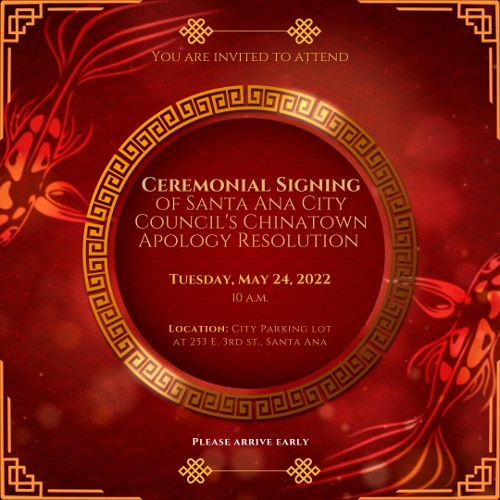Members of the public are invited to a ceremonial signing of the City Council’s resolution apologizing for the burning of Santa Ana’s Chinatown in 1906.
The event will take place at 10 a.m. on Tuesday, May 24, 2022, at 253 E. 3rd St. (City parking lot across from the original Chinatown site.)
On May 17, the City Council unanimously approved a resolution apologizing to Chinese immigrants and their descendants for acts of fundamental injustice and discrimination, seeking forgiveness and committing to the rectification of past policies and misdeeds.
Here is an article we wrote about the burning of Santa Ana’s Chinatown, which was published in 2010:
Remembering Santa Ana’s Chinatown
Picture Courtesy of the Orange Coast Voice
Did you know that Santa Ana used to have a Chinatown? There is no evidence of it today, because the Santa Ana City Council, way back in 1906, ordered it to be burned down.
Hard to believe, isn’t it?
Here is how the L.A. Times reported it:
Before the permit-only parking lot and car dealership appeared on 3rd Street between Main and Bush streets, this was home to men who wore dark queues down their backs, worked hard for cheap wages and sent their savings home to China.
The tiny Chinatown hamlet, which sprang up in the 1880s and thrived for more than 20 years, consisted mostly of redwood shanties. The men who lived there had left their wives and children in China and come to Orange County to build railroads, labor in the local grape and celery fields, and start up small businesses.
Santa Ana residents speculated then that nasty things were the norm among the 200 or so hard-working, hard-gambling Chinese. The local press called them “heathens.” The city fathers called the strange neighborhood “an eyesore.” The City Hall stood right next door.
And so on May 25, 1906, Chinatown suddenly vanished in flames.
The City Council used the excuse that a resident of the shantytown had leprosy. Many doubt that today. But at the time it was a convenient excuse to burn down Chinatown.
The Bowers Museum has a web page about the incident, but they admit there are few, if any pictures of this Chinatown, and they don’t have any of them. They do however offer an article from the now-defunct Santa Ana Journal that summarized the incident and offered this “happy ending:”
As it turned out, the Chinese were better off than before, as a result of the fire. They were given houses near the river, equipped with new bedding and other articles of domestic life, including stoves.
The Chinatown property belonged to a Mrs. Shaffer, and for a time she is reported to have entertained ideas of suing somebody about the fire. It is understood, however, that the matter was settled out of court.
Somehow I don’t buy that the Chinese were better off after the fire. I suspect most of them left town after the incident.
Why were they here in the first place? I found this note in an article on the Orange Coast Voice website:
It was a need for foreign labor that led to the first wave of immigrants to the United States from China. Chinese farm workers were hired by German settlers in Anaheim who needed laborers to cultivate grapes on their vineyards in the mid-19th Century. Asian American Studies scholar Patricia Lin notes that the Chinese were not only “expert grape growers and pickers, but they were used extensively in the construction of irrigation ditches, wine cellars, and casks.” One hundred twenty-five Chinese would later work to extend the Southern Pacific Railroad line from Los Angeles to Anaheim in 1873 and to Santa Ana in 1877.
The same article also cites what happened to the unfortunate denizens of Santa Ana’s Chinatown:
The neighborhood had been occupied by about 200 Chinese, who were evacuated before the fire. Calling the fire a “holocaust,” The Los Angeles Times reported, in language reflective of the era, that the “burned-out chinks” would be compensated. But in the end the city refused to pay the displaced residents more than trivial compensation.
Now that sounds a lot more believable to me!
Shouldn’t the City of Santa Ana put up a marker on the site of the burned out Chinatown, noting what happened? It would be a nice way to acknowledge the contributions the Chinese made to our area – and the price they paid in the end.

